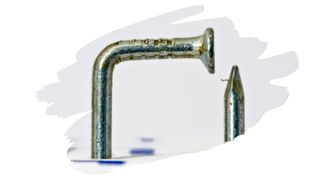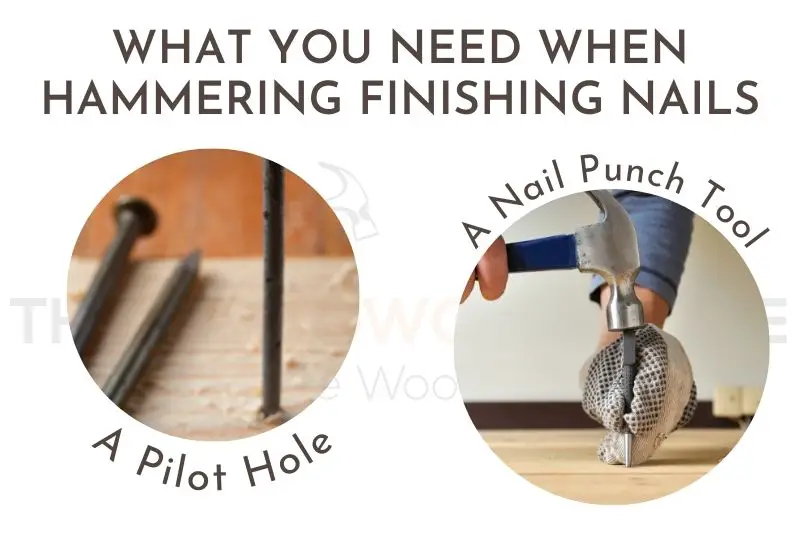Finishing nails can be tricky little things to work with, and you will need more than just a good old fashioned hammer to nail these fasteners into place.
That’s because the heads of these nails are much too small hammer them all the way home. You do that, and you are more likely to leave hammer dents in that trim. Which is far from ideal.
With nail heads that are barely wider than the nail shank itself, those fine finishing nails need a more precise tool if you want them to go in flush.
So, what tools can you use?
Well, you have two options; you can use a finish nailer power tool, or you can use a nail set.
Related Post: What’s The Best Nailer For MDF Trim? (Everything You Need To Know)
Finish nailers are powered hand tools that make quick precise work of fastening finishing nails – even at awkward angles.
Whilst, a nail set is used alongside hammers to drive nails. They do this by effectively turning that small finishing nail into a bigger target for you to hammer flush.
But, what if you have all the right tools, yet still your finishing nails keep bending?
Well, some of the main reasons why they bend tend to be that:
- You are driving those finishing nails into very dense wood, (such as Oak wood).
- The finishing nail has hit something metal that’s nestled behind the trim (i.e. screws or studs).
- Or, you are driving those finishing nails into wood without a pilot hole.
But, to be perfectly honest, finishing nails are just really difficult to hit home manually. You need to be over-the-top precisely straight with each blow, when it comes to hammering these things head-on.
So, what can you do to make sure that finishing nails stay on the straight and narrow?

This post may contain affiliate links to products that we receive a commission for (at no additional cost to you). Learn more here.
First Off, How Do You Properly Hammer In Finishing Nails?
By using a nail set, (sometimes referred to as a nail punch tool).
A nail punch is a steel hand tool. And it’s purpose is to give you a bigger target to hammer at.

You use a hammer to set the nail into wood, (guided by a pilot hole), as per usual. However, you do not hammer the nail down flush against the surface.
Instead, once the nail is part-way in, you use a nail set to help you hammer the finishing nail until it sinks right down into the wood.
What Is The Difference Between A Brad Nail And A Finishing Nail? Brad nails are fine long 18ga nails. While finishing nails are 15ga or 16ga nails, and typically have more holding power than brad nails. Learn more about brad nailers in our complete product guide here: Best Cordless Brad Nailers [Reviewed]
So, How Do You Stop Nails From Bending When You’re Hammering?
Well, first off, make sure you are using the right tools and prep for the job.
If you simply go straight in with a hammer, that is going to be the main cause of a lot of your bending issues right there. Instead;
Use a Pilot Hole (Proper Preparation)
A pilot hole is a small pre-drilled hole. We set the nail in this hole as a ‘guide’ for us to hammer through.
Quick Note: You only need pilot holes if you are nailing manually. You won’t need them if you are using a power tool like a finish nailer.
If you are nailing into hard dense wood, then you are going to definitely need these pilot holes. Without these pre-drilled guides, you will hammer and bend that nail every which way, again and again.
Use a Nail Set (For Manual Hammering)
Get yourself a nail set and save yourself the headache of trying to tap those finishing nails ever so precisely into place.
And don’t even bother trying to hammer finishing nails without a nail punch tool set, it just won’t work out.
If you’re after a crisp and professional looking finish, quarter round molding is a great way to go. It’s easy to install, so you can get a perfect seamless look in almost no time at all.
But believe it or not, for achieving a flawless looking baseboard installation, nothing works better than finishing nails.
So, if you ever thought your baseboards could use some extra style, then this post is for you: Should You Use Brad Nails Or Finish Nails For Quarter Round Molding?
Use a Finish Nailer (To Save Time)
Honestly, you will save yourself time, frustration (and likely your knees too) by just purchasing a finishing nailer for the job.
Most finish nailers are pretty affordable and easy to use. And they can drive nails straight, time and time again.
For example, the Ryobi P325 One+ is a 16 Gauge Straight Finish Nailer that makes quick work of punching nails into trim, and you don’t need to bother with making pilot holes for each nail.
The Ryobi can drive up to 800 finishing nails off a single charge. Plus, thanks to the fact that this nailer is battery-powered, you don’t need to worry about air-compression faults.
If you’re wanting to DIY some shelves and want to speed the process up, a power nailer is the way to go. But what nail should you use — Brad nails or Finish nails? In this post, we’ll talk about which nail is the better choice for securing bookshelves, giving them the strongest hold: Are Brad Nails Or Finish Nails Better For Setting Up Your Bookshelf?
To Quickly Wrap Up…
Sometimes figuring out why those nails keep bending can be almost as tricky as hammering them in the first place.
But, if you are trying to nail manually, your best broad stroke solution is to simply switch to using a powered tool.
A quality finish nailer, (that has the correct sized nails to go with it), will solve your bendy-nail issues.



